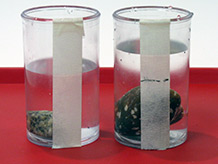What causes the water level to rise?
1. Ask the question

Show the students the two containers of water and the two rocks.
- What do you predict will happen when I add this larger rock to this container of water?
As students predict, ask them to explain their reasoning.
Before placing the rock in the water, show students how to draw a line to record the initial water level. Demonstrate lowering your eyes to the level of the water to accurately see its level and then draw a line on the masking tape. Next, use a fork to lower the rock into the container. Explain that you don’t want any water to splash out because that would change the amount of water in the container. When students have confirmed that the water level has risen:

What do you think caused the water to rise?
Students may say, "The rock pushed the water away," or "The rock is heavier than the water so the rock went down and the water went up." Some may suggest "size" or "volume" is responsible, or maybe "pressure" or "gravity." Accept all suggestions without comment for now.
Show students the smaller rock.
- What will happen when I put this smaller rock into the second container? Will the water level rise the same amount? More? Less? Why do you think so?
Before lowering the smaller rock into the second container, make sure the water level matches the starting level marked on the first container. Use the pipette to add or remove enough water to get them exactly equal, then mark the container. Use the fork to lower the smaller rock into the water without splashing.
- What do you notice?
Displacement: When an object is submerged or partially submerged in water, the object displaces, or "puts out of place" the water originally in the space now occupied by the object. This happens because two objects cannot occupy the same space at the same time. Scientists call this phenomenon water displacement. Water leaves no space between itself and a submerged object, so when an object is added to a container of water, the volume of stuff below the water line increases from the volume of just the water to the volume of the water plus the submerged object.
Students should see that both rocks caused the water level to rise, and that the larger rock raised the water level more than the smaller rock. Let students know that the scientific term for this change in water level is water displacement. The water moves away because the rock has taken its place.
- Why do you think one rock displaced more water than the other?
- Is it the weight of the bigger rock or its volume? How can we find out?
Have students brainstorm among themselves, then ask them to share their thoughts with the class. Listen for a suggestion of a controlled comparison or "fair test", i.e., to test two objects with the same volume but different weights — or the same weights but different volumes — and observe the difference in the amount of water that is displaced.



